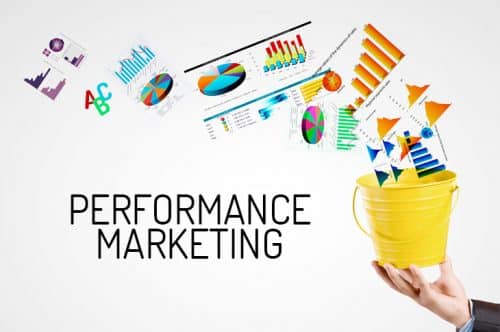The fundamental premise of performance marketing is straightforward. You only pay for marketing performance, such as ad clicks, lead generation, conversions, and so on. While this may appear to be a fresh concept, performance marketing has been present since the mid-1990s with the introduction of Pay-Per-Click campaigns.
The rise of performance marketing, also known as performance-based marketing, is due in large part to new technology that allows businesses to collect more data on their traffic and campaign performance. This data access enables them to better attach value to the activities that are most successful, and to adjust advertising accordingly.
If you’re ready to learn about one of the fastest-rising marketing trends, we’ve put together a comprehensive reference to performance marketing and its metrics.
What is Performance Marketing?
Performance marketing is a broad phrase that refers to online marketing and advertising programs in which advertisers (also known as “retailers” or “merchants”) pay marketing organizations (also known as “affiliates” or “publishers”) when a specific action, such as a sale, lead, or click, is completed.
What distinguishes Performance Marketing from other Types of Marketing?
In more traditional forms of marketing, the payment arrangement is flipped; advertisers pay first, and publishers then run ads. This type of marketing has a role, especially when it comes to building brand awareness. Sometimes the initial step is simply informing potential customers that the business exists and what services it offers. These ads can be found on social media, websites, and applications. Of course, there is no interactivity with previous sorts of TV and radio ads. So there is no instant, quantitative way to determine impact.
Of course, there are negatives to brand marketing. “Metrics connected with performance marketing — likes, favorites, retweets, and perceived equivalent media value — all have some sort of impact,” Forbes notes. However, they are not always visible on a client’s bottom line. That is, the customer paid the agency a large charge in exchange for increased exposure, but nothing more.”
Consumers nowadays are constantly staring at a screen and hundreds of companies vying for their attention on a regular basis. It’s no surprise that more and more marketing professionals are turning to performance marketing to focus on results.
Performance Marketing Metrics
Data visualization options abound today, especially with a wide range of analytics platforms. So creating dashboards that display all of your essential performance data in one perspective isn’t difficult. But how will you know which ones to monitor in order to gain vital insights into how to proceed? Here are the top eight performance marketing metrics that every performance marketer should pay close attention to and learn from.
#1. Impressions
Impressions, which relate to how many times your ad has been shown on a specific website or in a mobile app, are one of the most fundamental marketing metrics reflecting your ad performance. As an example, whenever time your ad appears on a Google search result page or your banner appears on one of the Google Display Network sites. So, this counts as an impression. It’s important to remember that this is the number of times your ad is displayed on the website. It’s not necessarily seen by an actual person, but it does create an opportunity to get eyes on it.
In a world where bots create 40% of internet traffic rather than humans, the overall number of impressions may not accurately represent the real performance of your ads. Third-party ad verification providers, such as DoubleVerify or MOAT, have addressed this issue. Also, advanced data management tools, can integrate data from these suppliers and match it with Impression data from the ad platforms you are utilizing. This allows you to know how many times your ads were seen by actual people and potential consumers.
#2. Clicks
Clicks is another simple performance marketing metric that captures each time a user interacts with your ad, eventually landing on a page from the connected CTA. By tracking the number of clicks, you can get a sense of how appealing your ad is to individuals who view it. This is because they’re willing to act and learn more based on the information in the ad. However, because many ad platforms may register (and charge) a click even if the user was unable to land on your website or another link target due to network or technical challenges, the figure may not be entirely accurate.
Cross-referencing it with data from your website analytics tool, such as Google Analytics, will provide you with a clearer picture of potential client loss due to technical or other issues on your website. Nonetheless, clicks are an important element in the performance marketer’s toolbox, especially when measured over time. Of course, depending on the intricacy of your campaigns, you can look at these Impressions and Clicks as a whole or segment them based on various criteria such as geographic location, user demographics, technological platform, and a variety of other factors.
#3. Click-through Rate (CTR)
The CTR is a computed KPI that takes Clicks and Impressions and adds a new dimension to them. It is calculated by dividing the total number of clicks received by your ads by the total number of ad impressions. CTR is one of the most important performance marketing metrics of ad efficiency. It is prominently displayed on many performance marketers’ dashboards. When it comes to Google Ads, you can view your CTR by campaign and ad group. This allows you to fine-tune your strategy and execution.
Examining your CTR data in further depth allows you to identify high-performing ads, ad groups, and campaigns that would benefit from a higher budget or bid value, as well as those that are failing, requiring you to limit spending or even disable them. It’s worth noting that while your total CTR for a campaign may be good, the click-through percentages for individual ad groups you’re utilizing may not be, and this could be holding things back. As a result, by regularly monitoring CTR at all levels, you can more effectively optimize ad spending.
#4. Cost
Of course, if you have a limited budget, the amount of money you spend on ads may be one of the most important performances marketing metrics to monitor. As a result, cost should be prominently displayed in your performance marketing dashboard. Combining ad spending from different platforms can be time-consuming. So having a data integration solution that can automatically collect and process data from multiple platforms at once would greatly speed up and simplify things.
#5. Average CPC
Average Cost-per-Click (CPC) is one KPI that requires a slightly more in-depth look at the data behind the scenes. So an ad platform will usually do the math for you automatically. CPC is calculated by dividing the cost of your clicks by the total number of clicks received by your campaign. So, it is an important first step in determining the profitability of your promotional campaigns. Your Average CPC can range from a few cents to hundreds of dollars or euros, depending on industry and geography, among other factors. In any event, one of the most difficult tasks in marketing is keeping your CPC as low as possible while not jeopardizing ad delivery by limiting the number of impressions.
#6. CPM
While we’re on the subject of impressions, another important metric to consider is CPM or Cost-per-Mille. It displays the cost of 1000 ad impressions and is useful for branding and awareness campaigns, as opposed to direct conversion and acquisition campaigns, where CPC values are more important. Again, because the number of impressions is not a very exact performance indication, as previously stated, an extra performance marketing metrics – vCPM or Viewable CPM, which sets a cost per 1000 watched impressions – is frequently utilized.
#7. Conversions
Conversions are a step above Clicks and CTRs in that they demand users to perform a specific action after interacting with your ad. A conversion, for example, needs people to take one step further and click through your website to a certain page, sign up for a subscription, phone your business, or complete an online purchase after they have read your ad or seen your video and clicked on the CTA.
Tracking these is more difficult than tracking the previous performance marketing metrics since it demands the ability to follow the consumer across several platforms and channels and monitor your outcomes while accounting for the various devices and channels used. This appears to be a “mission impossible” in a very interconnected world, especially with existing and forthcoming legislative reforms that hinder firms from gathering as much information about their customers as they would like (or are able currently). Setting up Conversions differs between ad platforms. After you’ve done so, you’ll be able to fully comprehend the ROI of your ad campaigns.
#8. Cost Per Conversion
In addition to understanding your conversion figures, another indicator worth measuring on a regular basis is Cost per Conversion, which is your ad expenditure divided by the number of conversions generated. This indicator can rapidly show you which campaigns are on track and which are not; or, in other words, which ones are consuming too much of your ad budget while providing an insufficient return. This may encourage you to re-examine the various layers of a poorly performing campaign and make changes to aspects such as ad content, messaging, graphics, CTAs, landing pages, or other marketing assets linked to the campaign you’re optimizing. You might also reallocate your budget to another campaign entirely.
#9. CPA
CPA is an abbreviation for Cost Per Action, and it assesses campaign performance based on a certain desired action you want your target audience to take, such as downloading an ebook, joining up or subscribing, purchasing an item, or some other action. Because the action done by potential customers is regarded as the most essential tangible and measurable consequence in performance marketing, CPA is also one of the most important and popular metrics.
#10. LTV
This measure focuses on an individual customer’s expected “Lifetime Value” during the course of their engagement with the brand or organization. Using advanced methodologies such as predictive analytics, LTV assesses the projected spending of recruited customers based on their ongoing activities. LTV is quickly becoming one of the popular performance marketing metrics, owing to increasingly advanced measurement capabilities. It assists marketers in planning their overall strategy with the ultimate goal of enhancing ROI.
Read Also: Fortune Global 500: 2023 Complete List Ranking & Analysis (Updated)
How to Create a Performance Marketing Plan
Because there are so many different kinds of performance marketing channels and campaigns, there is no one way to execute them. However, these are the primary phases in developing a performance marketing plan for any type of audience. Use them as a roadmap to get your performance campaign up and running.
Step 1: Determine your campaign’s goal.
It is critical to creating campaign goals before you can measure the performance of any campaign. Setting goals prior to launch, whether for brand awareness or product sales, is the very foundation of performance marketing.
Many ad platforms require you to set goals before you can create ads or build-up campaigns. Your campaign goals affect where your ads appear, who sees them, and other critical success criteria.
The following are the most popular digital marketing objectives:
- Brand Recognition
- Website Visits
- Remarketing or retargeting
- Engagement
- Creating Leads
- Sales
Once you’ve determined your campaign objectives, you can use ad platforms to construct campaigns that specifically target those objectives.
Step 2: Select a digital channel (s)
It is better to diversify your channels of communication in performance marketing than to rely just on one. This broadens the campaign’s visibility and reaches, increasing its chances of success. Look for channels that specialize in your conversion type and where you are most likely to reach your target audience, whether it’s affiliate marketing, native advertising, or social media platforms.
You can substantially enhance your potential reach and expose your performance campaigns to a far larger audience by diversifying on multiple social media networks, for example, or expanding from standard display ads to native advertising.
Step 3: Design and launch the campaign
A large portion of performance marketing labor is spent on campaign creation. This includes identifying the target demographic, analyzing their pain points and desires, and producing ads and content to satisfy their requirements and capture their attention. The more you know about your target demographic and how your product or service might appeal to them, the easier it will be to generate the ideal ad language, design, and scheduling. Of course, the technical aspects of the campaigns, such as ad widths, copy character restrictions, and suitable images, are also affected by the platform or channel you are utilizing.
Step 4: Evaluate and improve your campaign
The actual effort begins after the launch. The instant a performance campaign is launched, it begins to create data. It is the marketer’s responsibility to optimize individual campaigns for performance across all channels in use. Keep an eye on analytics and stats to see which traffic sources are doing the best. After that, you can then allocate ad expenditures accordingly. Use performance marketing campaigns to maximize your return on investment by identifying your best channels, audiences, and campaign objectives.
Step 5: Deal with potential stumbling blocks
Performance marketing, like any other marketing campaign, can present some difficulties and risks. These could include:
- Brand security
- Concerns about compliance
- Regulations Concerning Privacy
- Bot traffic and click fraud
- Publisher deception and placement transparency
Focusing your resources on high-quality advertising networks and platforms where issues like brand safety and data privacy are handled properly and reliably is one method to reduce possible difficulties from the start.
Advantages of Performance Marketing
Native advertising is a prime example of performance marketing in action. Advertisers construct ad campaigns with a specific conversion objective in mind and only pay for clicks or other conversion actions. Compare this to a TV ad, which may run for a set period of time and frequency, but there is no guarantee as to how many people will see or respond to it.
This gets to the heart of what performance marketing has to offer. Performance marketing focuses on tracking and attribution, giving advertisers far greater control over their budget and ROI.
The top three reasons why performance marketing is the new marketing are as follows:
#1. Performance that is simple to track:
Performance marketing campaigns are put up with the express objective of tracking and measuring. Keeping a finger on the pulse of performance campaigns and adjusting them to get better results is simple with the help of various data analytics tools designed specifically for performance marketers.
#2. Low risk:
Marketers understand exactly what is happening with their performance campaigns at every stage. Thus, putting them in a much better position to optimize and reduce risk as needed. Furthermore, with less risk, faster launch times are possible. There will be no more pleading for approvals.
#3. ROI-driven:
Because performance marketing is driven by ROI, the emphasis is always on the end goal of improving performance. This guarantees that performance campaigns are always striving for greater results. This helps to elevate the brand across all KPIs and increase leads and sales.
Examples of Performance Marketing
#1. Avon – Programmatic native video
Avon, the iconic beauty brand, is an excellent example of how native programmatic can be used for performance campaigns. The brand collaborated with its Brazilian media agency to create a video focusing on women’s empowerment, raising awareness of its support for women’s problems such as battling gender inequality and breast cancer. Avon was able to measure and track the ad’s excellent performance on premium publisher sites on the Outbrain network by utilizing Outbrain’s native video inventory, which is available programmatically on Display & Video 360: Video completion rates were 63 percent, and 70 percent of consumers watched more than 75 percent of the video.
#2. Outbrain – Search marketing campaign
Outbrain’s Growth Marketing team employs a variety of performance tactics to raise awareness and generate leads for the Outbrain recommendation platform. The team recently launched a brand search campaign in Italy, with paid search ads displayed to users searching for “Outbrain” online, leading to a sales landing page.
The campaign performed admirably, with a CTR of 18.47 percent, a CVR of 13.39 percent, and an astounding ROI of 2028 percent. This means that for every $1 spent on the search campaign, a return of $20 was obtained.
#3. VAVAVOOM – YouTube video marketing campaign
TrueView for Action is a Google Ads video campaign type that tries to increase conversions and leads with action-driving features. VAVAVOOM, a global fashion retailer, saw some extremely outstanding results from a YouTube video campaign that used TrueView for Action. To achieve this aim, the company targeted a ROAS of 10:1, combining the TrueView campaign with unique intent audiences and in-market targeting. They far outperformed expectations, achieving 304,517 engagements throughout the 11-week campaign and a ROAS of 1409 percent.
What Are Some Performance Marketing Trends to Keep an Eye On?
Every form of marketing, including Performance Marketing, is constantly evolving.
With this type of marketing accounting for more than 16 percent of eCommerce sales in 2017, it’s clear that this strategy’s growth is increasing at a rapid pace.
As a driving driver for eCommerce conversions, this percentage places Performance Marketing on a level with email marketing and ahead of display advertising.
With this expansion, more people are pursuing a career in Performance Marketing, more marketers are investing in it, and more publications are entering the area.
With an increase in influencers, performance-based technology businesses, and content sites, your company will have more options to advertise itself in the performance marketing area.
Furthermore, with more options for improved tracking and attribution thanks to third-party tracking platform enhancements, these enhancements enable first click models where publishers can rest assured that they will not be penalized if someone leaves their referral and returns to buy from a different source.
Multi-touch, position-based, time decay, and linear choices are also fresh innovations to watch for in tracking and attribution.
Another fascinating trend to keep an eye on in Performance Marketing is the continuous development and application of Artificial Intelligence (AI) and Machine Learning to drive sales on a performance basis.
Automation, segmentation, personalization, and optimization are four areas to keep an eye on – because to AI and machine learning, these keywords are gaining traction.
In Performance Marketing, marketers must track and measure hundreds or thousands of data points, if not millions or billions.
Using machine learning, AI removes the complexity from these data points and allows for seamless scaling of effective optimization.
Adapting to this expanding trend also allows marketers to free up their time. Thus allowing them to be more innovative in their marketing efforts and receive more value for each dollar invested.
How can performance marketing be used to drive business growth?
Performance marketing can drive business growth by focusing on the most important marketing metrics such as cost per acquisition (CPA), return on ad spend (ROAS), and customer lifetime value (CLV). By continuously optimizing these metrics, a business can achieve sustainable growth over time.
What are the current trends in performance marketing?
Some of the current trends in performance marketing include the use of artificial intelligence (AI) and machine learning (ML) for optimization, the increasing importance of cross-device tracking, and the growth of programmatic advertising.
How does performance marketing fit into an overall marketing strategy?
Performance marketing is a subset of an overall marketing strategy, and it is often used to complement other marketing efforts. For example, a business may use performance marketing to drive quick wins in the short term while building a brand through other marketing channels in the long term.
What are the ethical considerations in performance marketing?
Performance marketing raises a number of ethical considerations, including privacy, data protection, and the use of misleading or deceptive marketing tactics. Businesses must take these considerations into account and implement best practices to ensure that their performance marketing campaigns are responsible and in line with industry standards.
How does performance marketing impact customer acquisition costs?
Performance marketing can have a significant impact on customer acquisition costs by providing a more efficient and cost-effective way to reach customers. By focusing on specific goals and metrics, businesses can minimize waste and optimize their marketing spend, ultimately leading to lower customer acquisition costs.
Final Thoughts
Performance Marketing, in general, is a developing marketing technique for eCommerce brands, merchants, and retailers alike. The trends suggest that investment in the channel is continuing, with new companies entering the field and new technology being used in order to maximize results better, faster, and cheaper.
The ties between numerous moving parts in performance marketing are highly valued, from the affiliate managers who drive relationships and strategy to the third-party tracking platforms that track and credit campaign results. Performance Marketing enables the scaling of reach, engagement, and conversion of new buyers in new areas at a lower cost, lower risk, and far higher ROI than any other marketing channel at scale.
Performance marketing allows you to establish your brand, enhance product recognition, and engage with customers without the constraints of money or competing marketing channels. It’s a piece that gets put on top and can provide an average of 16% to your top and bottom lines.
Working with publishers, affiliate management organizations, and affiliate networks as an extension of your brand provides you with an additional reach that you might not have had using more traditional marketing methods. Whether you currently have an affiliate network, it is a good idea to assess your strategy and program to see if you may benefit from adding an outsourced management team to the mix or totally managing the program.
If your objectives and measurements are clearly established, performance marketing is a win-win for both marketers and affiliates. This method will assist you in measuring and tracking your ROI, as well as providing a chance to fine-tune your campaign(s) based on their performance. Of course, experimenting and testing will assist you in determining the best balance of various sorts of performance marketing. Always test, track, measure, and optimize.
Performance Marketing FAQs
What are the types of performance marketing?
Social media, native ads, CTV ads, audio ads, display ads, and search marketing are all forms of performance marketing. These expose your brand to the viewers on each platform, allowing you to enter new markets.
Is SEO part of performance marketing?
By definition, SEO-based campaigns are not performance marketing because you cannot pay for the results and have no control over how you acquire visibility on search engines. However, we can employ a performance-based attitude to create stronger SEO campaigns for our company.
What is the difference between performance marketing and digital marketing?
Digital marketing is the use of online channels for marketing or promotion. Performance marketing is a type of digital marketing in which you only pay when a specific outcome occurs.
What is a performance marketing platform?
A performance marketing platform is used to track and analyze data points from a campaign, such as leads, clicks, conversions, and bounce rates. It allows you to simply analyze performance, cost per acquisition, assign proper attribution and optimize your marketing efforts by bringing everything together.





